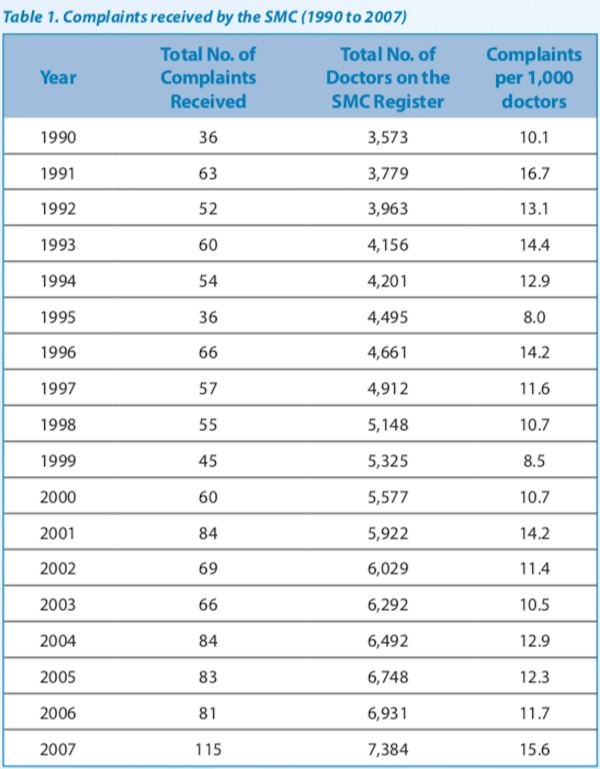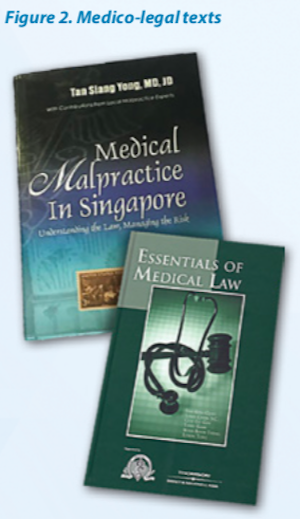Introduction
The SMA has 60 years' history of working with doctors and patients. With regard to medico-legal issues, its objective is "to support a higher standard of medical ethics and conduct; to enlighten and direct public opinion on problems of health in Singapore". The activities and events in the local medico-legal landscape where the SMA has played a role are briefly presented.
SMA Lecture
The SMA Lecture was instituted in 1963, by a grant from the SMA to the Faculty of Medicine to establish an annual lecture on medical ethics and related topics. The list of SMA Lecturers and the topics of their lectures are available on the SMA website.1
SMA Ethics Committee
Since 1966, the SMA Ethics Committee has been a committee of the SMA Council. It started with just an advisory function, but took on more tasks over the years. When its work was reviewed in 1999, the Committee had four key types of activities: operational, consultative and liaison, policy, and education.2 Creation of the advisory on advertising, and the advisory on breast and chest examination of female patients, are examples of policy activities.
Position statements and advisories
The SMA website has to date 15 Position Statements and 18 Advisories, mostly from the SMA, with a few from other stakeholders including the Singapore Medical Council (SMC), Central Narcotics Bureau and the Ministry of Health (MOH).3 The oldest in the list was issued by SMC in 1994, on "Issue of Medical Certificates".
Complaints against doctors
Complaint rates per 1,000 doctors
Figure 1 shows the rates of complaints lodged with the SMC from 2008 to 2017.4 The number of complaints per 1,000 doctors ranged from a low of 10.6 (in 2009) to a high of 17.2 (in 2014). Table 1 shows the complaint rates from 1990 to 2007. They ranged from 8.0 (in 1995) to 16.7 (in 1991).5,6


Why do patients complain?
An Editorial in the Medical Journal of Australia,7 written by Paul Nisselle, chief executive of the Medical Indemnity Protection Society, Melbourne in 1999, has an important evergreen message to share: "Medical treatment is not entirely risk-free. The doctor-patient relationship involves two individuals – both human, and therefore fallible. One seeks assistance with a problem and the other has the skills to deal with the problem. In this human interaction, anything can go wrong. A doctor may be responsible for a negligent act or omission, or a patient may wrongly accuse a doctor of negligence." He gave a list of seven things to do when an adverse event occurs (see Table 2).

Why do people sue doctors?
A study published by Charles Vincent et al,8 in 1994 in the Lancet gave useful insights. Of the 227 patients and relatives taking legal action through five firms of plaintiff medical negligence solicitors in London, four themes were found:
Singaporean patients and their significant others are likely to be no different in thoughts and actions. Given this set of answers, it may explain why mediation does not always work.
SMA Centre for Medical Ethics and Professionalism
The SMA Centre for Medical Ethics and Professionalism (SMA CMEP) was set up in SMA to fill a need. "In the late 1990s, the leadership of SMA and members of the SMA Complaints Committee realised that in addition to dealing with complaints from patients against doctors (a "firefighting" mode), a proactive approach to reduce and prevent complaints was necessary. The understanding at that juncture was that many of the complaints had resulted from deficits of medical education, in the domains of professionalism, medical ethics, health law and communication science. The strategy was to build educational resources and courses to provide the skills and knowledge to doctors in order to reduce the number of complaints."9
Two persons were pivotal in the setting up of SMA CMEP. The first is Prof T Thirumoorthy. He was very much instrumental in setting up the SMA Ethics Course for specialists and family physicians in training as one of the key activities of the Centre. His vision is that eventually, all people who practise medicine and those who volunteer or are appointed to sit in judgement of their fellowmen will be formally trained and skilled in the art and science of medical law. Recent events testify to the wisdom of his vision.
The second is Prof Tan Siang Yong, affectionately referred to as "SY" by those of us who know him well. In 1999, MOH invited Prof Tan to be its Health Manpower Development Programme Visiting Expert for healthcare ethics. Singapore was indeed very fortunate to have him back to advise and train us on principles of health law and ethics.
SMA CMEP celebrated its 15th anniversary in 2015. This was documented in the June 2015 issue of SMA News.9 The Centre is thriving – it runs the SMA Ethics courses, as well as the yearly medico-legal seminars to update doctors. A person who has worked hard in running and keeping the courses useful and interesting is A/Prof Lai Siang Hui. Many thanks are due to him.
Medico-legal texts
Two medico-legal texts were published in the time period of the setting up of SMA CMEP (see Figure 2). The first is titled Medical Malpractice in Singapore – Understanding the Law, Managing the Risk published by Prof Tan Siang Yong in 2002. What is remarkable is that this is a text by a single author who is both doctor and lawyer – quite an unbeatable feat. The first chapter of this book sets the stage of modern day medical practice in Singapore.10
The second medico-legal text of the same era is Essentials of Medical Law, published in 2004 by six authors: two doctors – Dr Yeo Khee Quan and me, and four lawyers – Mr Leslie Chew, Senior Counsel, A/Prof Terry Khan, Ms Kuah Boon Theng, Senior Counsel, and Mr Edwin Tong, currently Senior Minister of State for Law and Health. This book was launched by the then Solicitor-General Mr Chan Sing Onn.11

Medical practice and medical negligence
For medical practice to be acceptable to society, it has to fulfil two things: (1) the standard of care that meets the expectations (which must be realistic and grounded) of the medical profession of the day in a given community; (2) the duty of care as laid down by the law of medical negligence of the day by that community. The two are intrinsically intertwined. The Oration by our Chief Justice Sundaresh Menon on "Evolving Paradigms for Medical Litigation" is a timely update for medical practitioners.12
System problems
System problems in the delivery of healthcare can promote negative behaviours like defensive medicine. Singapore has managed to maintain equilibrium through the judicious application of the law of medical negligence. The recent departure from the Bolam-Bolitho tests to the modified Montgomery test has raised concerns of defensive medicine appearing. Two cases of inappropriate sentencing by the Disciplinary Tribunals triggered several petitions to MOH and SMC to seek guidance – the first time in the medico-legal history of Singapore. The Ministerial Statement on protecting patients' interests and supporting the medical community13 in reply to these petitions received on 1 April 2019 is positive, progressive and augurs well for the future of Singapore medical practice.
Discussion
As SMA celebrates its 60th anniversary of serving doctors and patients, it is timely to examine the report card of this organisation. In a nutshell, the SMA has done well in its medico-legal related tasks. The stewardship of medical leaders of the SMA through the ages, and the contributions of its volunteer doctors together with the staff have consistently served the medical profession and our society well.
Compared to medical practice 60 years ago, the medico-legal world of today has become more complex and challenging. This may create a sense of dread among the medical fraternity. Rather than to adopt a defeatist mindset, the medical fraternity needs to work collaboratively with the 4Ps (people, press, policy makers and professions) of the community, to create a better world in the spirit and substance of the book produced by the Institute of Medicine in United States in 1999, To err is human: building a safer health system.14 We must.
The recent medico-legal events in Singapore clearly spell the need to build a safer health system not only for the patients, but of equal importance to be safer for healthcare providers as well. With the exception of the occasional misfits, the rest of the medical practitioners do try to work diligently for the good of the patients and significant others whom they serve. Their best interests and mental health need to be nurtured and protected as well. The recent Ministerial Statement on protecting patients' interests and supporting the medical community augers well for Singapore as SMA celebrates its 60 years of existence.
From a medical practitioner's perspective, the following may be some things to reflect upon:
Conclusion
Sixty years on, we give thanks to the SMA, its leaders and contributors, including our SMA secretariat staff, for their efforts in nurturing us to practise well and to practise safely. Good medical practice is a life course of continuing positive engagement of all stakeholders to serve our patients, our community and ourselves better. To err is human; let us build a safer health system for Singapore. Carpe diem.